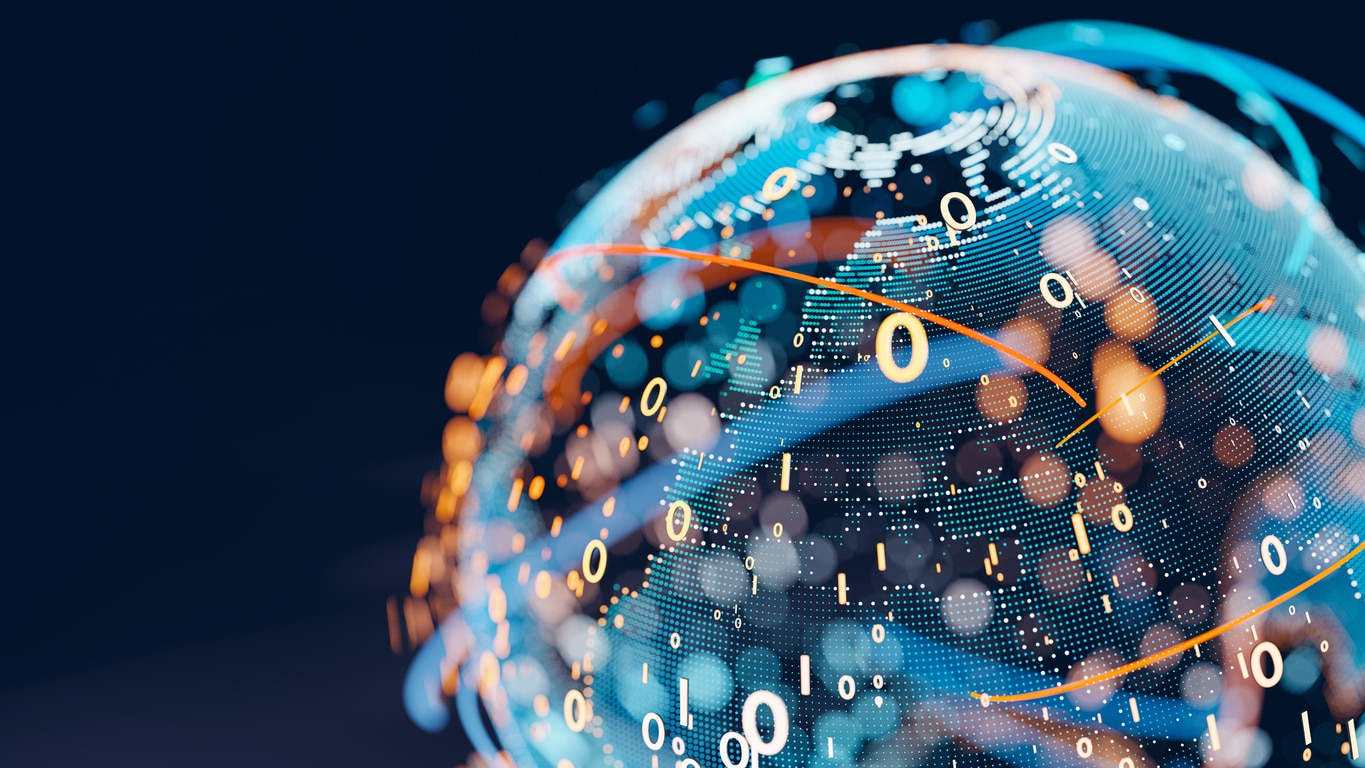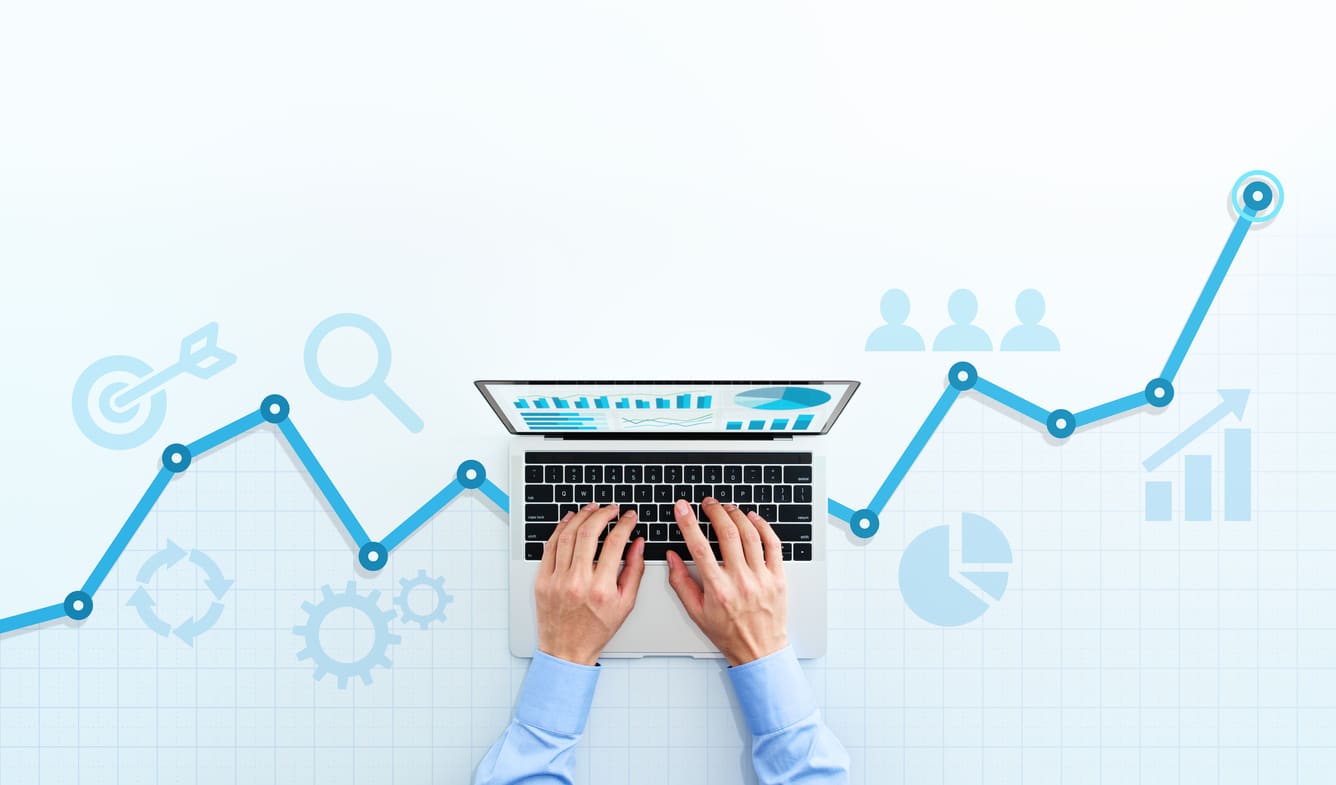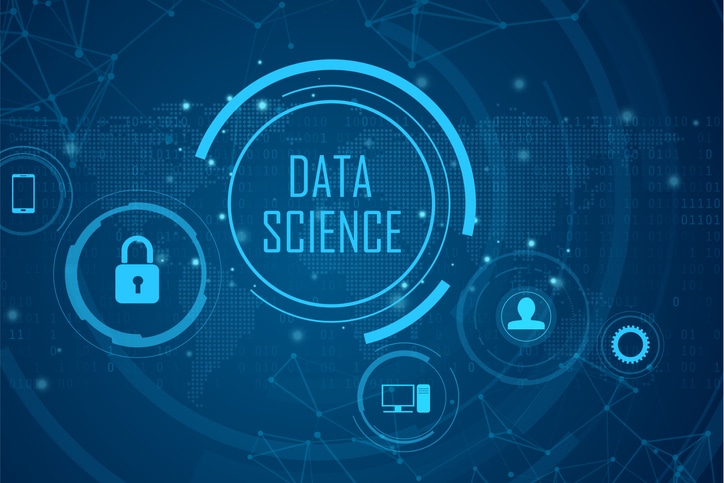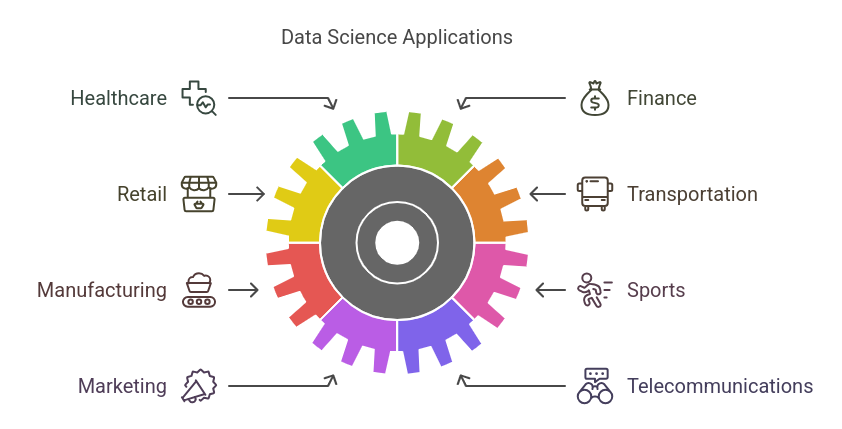Imagine you’re a business owner who’s been struggling to keep up with the latest trends. You know that in order to stay afloat, you need to be able to make data-driven decisions, but data is becoming more and more complex every day. What do you do?
Imagine you could get insights from all of your data in real time. Imagine you could prevent problems before they happen. Imagine you could make better decisions faster. This is where big data analytics pitches in. With big data analytics, you can do all of this and more.
Big data analytics is the process of turning large amounts of data into valuable insights. This data can come from a variety of sources, including social media, transaction data, and machine sensor data. By analyzing this data, businesses can unlock the hidden potential of their data and improve their performance in a number of areas.
The process of turning large data sets into actionable insights is quickly becoming one of the most important tools for businesses of all sizes. But what is it, exactly? And why is it so important?
In this article, we’ll break down everything you need to know about big data analytics. We’ll cover how it works, the tools and technology involved, and the many applications of this powerful process. Plus, we’ll give you a glimpse into the future of big data analytics and how it’s poised to change the world as we know it.
Evolution of Big Data Analytics
The evolution of big data analytics can be traced back to the early days of computing when organizations first started to realize the potential of using large data sets to find hidden patterns and trends.
One of the earliest examples of this was in the 1960s when the US government used big data to track the movements of Soviet submarines. Since then, big data analytics has come a long way.
With the advent of powerful computers and sophisticated software, it’s now possible to process and analyze large data sets much more quickly and easily.
When we talk about the history of big data analytics, we have to start with the term ‘big data itself. John Mashey first coined the term in 2001, and it referred to data sets that were too large and complex to be dealt with using traditional data processing methods. But it was in 2005 that the term started to gain traction when a group of scientists from Google published a paper on a new way of dealing with big data sets. They called it ‘MapReduce’, and it was a game-changer. Since then, there have been a number of other advances in big data analytics, including the development of new storage technologies, new ways of analyzing data, and new applications for big data.
This has led to a surge in the use of big data analytics, and it’s now being used by businesses and organizations all over the world to find hidden insights that can help them make better decisions.
Today, big data analytics is used in various industries, from retail to healthcare to finance. And it’s only going to become more critical in the years to come.
What is big data analytics?
Big data analytics is the process of examining large data sets to uncover hidden patterns and insights. This can be done manually, but more often than not, it’s done through the use of specialized software and hardware tools.
A big data analyst is someone who is responsible for analyzing large data sets to uncover hidden patterns, correlations, and other insights. They look for trends and patterns and then develop hypotheses about what those trends mean. From there, they develop plans to act on those findings.
This is a critical role in any organization, as big data is only becoming more and more important. This process of turning large data sets into actionable insights is quickly becoming one of the most important tools for businesses of all sizes. The insights gleaned from big data analytics can help businesses make better decisions about everything from product development to marketing to customer service.
There are several types of big data analytics, each of which suits a particular task. Some of the most common types include descriptive, predictive, prescriptive, and diagnostic analytics.
Each type has its own benefits and drawbacks, so it’s important to understand which one is right for your needs. For example, descriptive analytics is great for understanding what has happened in the past, while predictive analytics can be used to predict future trends.
The skills required to become a big data analyst include understanding and analyzing data, communicating data analysis findings effectively, working independently, and solving problems.
Why is big data analytics important?
You might be wondering why big data analytics is so important. And the answer is actually quite simple: because it helps businesses make better decisions.
You see, big data analytics takes all of the data that a business has collected and uses it to find patterns and trends. This information is then used to help businesses make more informed decisions about everything from marketing to product development.
There are several reasons why big data analytics is important. First, it allows businesses to make better decisions by understanding customer trends and behavior. Second, it can be used to improve products and services by uncovering hidden patterns and insights. And third, it helps businesses to save money by reducing operational costs and increasing efficiency.
In the past, big data analytics was primarily used by large businesses. However, the rise of big data and the proliferation of big data tools has made it possible for small businesses to get in on the action.
And the benefits of this are pretty clear. With big data analytics, businesses can save money, time, and resources by making decisions that are based on real data instead of guesses.
How does big data analytics work?
So, how does big data analytics work? In a nutshell, organizations collect data from multiple sources, including social media, websites, sensors, and more. This data is then stored in a data warehouse where it can be analyzed to reveal patterns and trends.
To make sense of all this data, organizations use special software that cleans and organizes it so that it can be effectively analyzed. This software can identify patterns and correlations that would be difficult to spot using traditional methods.
Once the data has been analyzed, organizations can use the insights they’ve gained to make better decisions about their business. For example, they might use big data analytics to improve their marketing campaigns or to develop new products and services.
Big data analytics involves using specialized tools and frameworks to process and analyze very large datasets. Here is a simplified overview of the process:
- Data collection: Data is collected from various sources, such as sensors, social media, and transactional systems. This data is often too large to store on a single machine and may be structured, semi-structured, or unstructured.
- Data storage: The collected data is typically stored in a distributed file system, such as HDFS (Hadoop Distributed File System), which allows it to be stored and processed across a cluster of machines.
- Data processing: Specialized tools, such as MapReduce and Spark, are used to process the data and extract insights from it. These tools are designed to be fault-tolerant and able to handle the scale of the data.
- Data analysis: The processed data is then analyzed using statistical analysis, machine learning algorithms, and visualization techniques to find trends and patterns.
- Results: The insights and findings from the analysis are then used to inform business decisions or to generate reports and visualizations for stakeholders.
Here is a diagram representing this process:
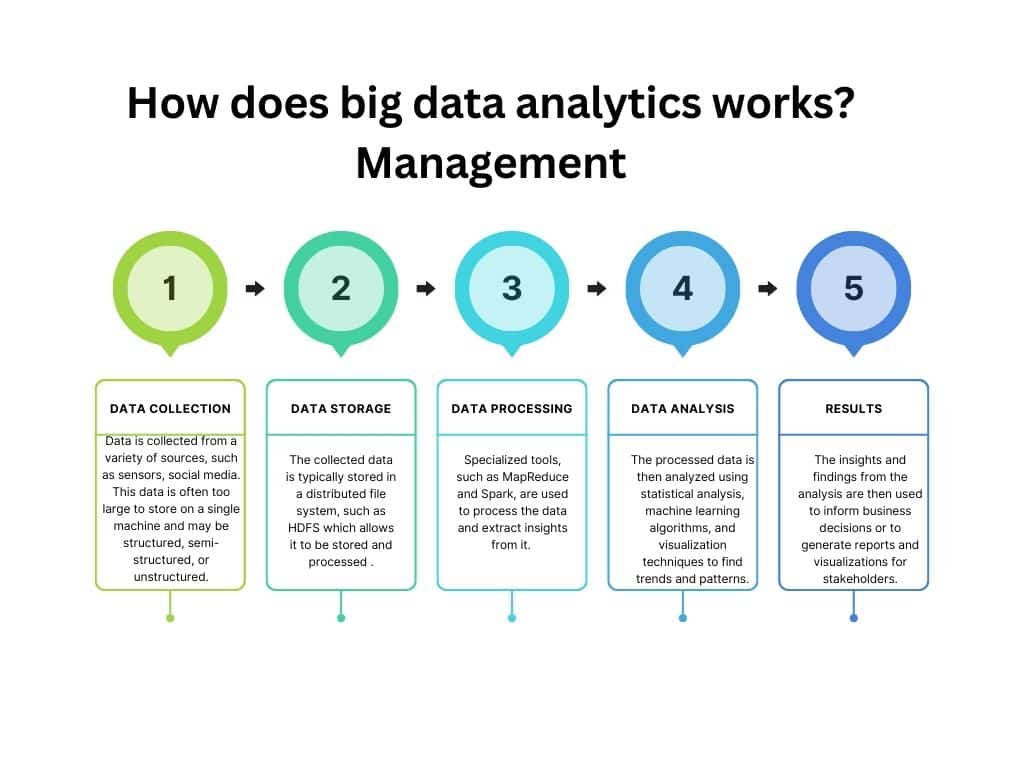
Life Cycle Phases of Big Data Analytics
The following are the phases in the life cycle of big data analytics in brief: 3
● Data Ingestion: This is the process of collecting, extracting, and loading data from various sources into a centralized data repository.
● Data Preparation: This is the cleaning, transforming, and preparing of data for analysis.
● Data Exploration and Modeling: This is the process of using various analytical techniques and tools to uncover patterns and insights in the data.
● Data Visualization and Reporting: This is the process of using visual aids to communicate the findings from the data analysis.
● Data Lifecycle Management: This is the process of managing the data throughout its lifecycle, from ingestion to visualization and reporting.
The data can be collected from various sources like IoT devices, Social Media, Images and Videos, Applications, and RFID and can be stored and integrated from diverse sources like NoSQL Data Bases, Data Warehouses, Data Lakes.
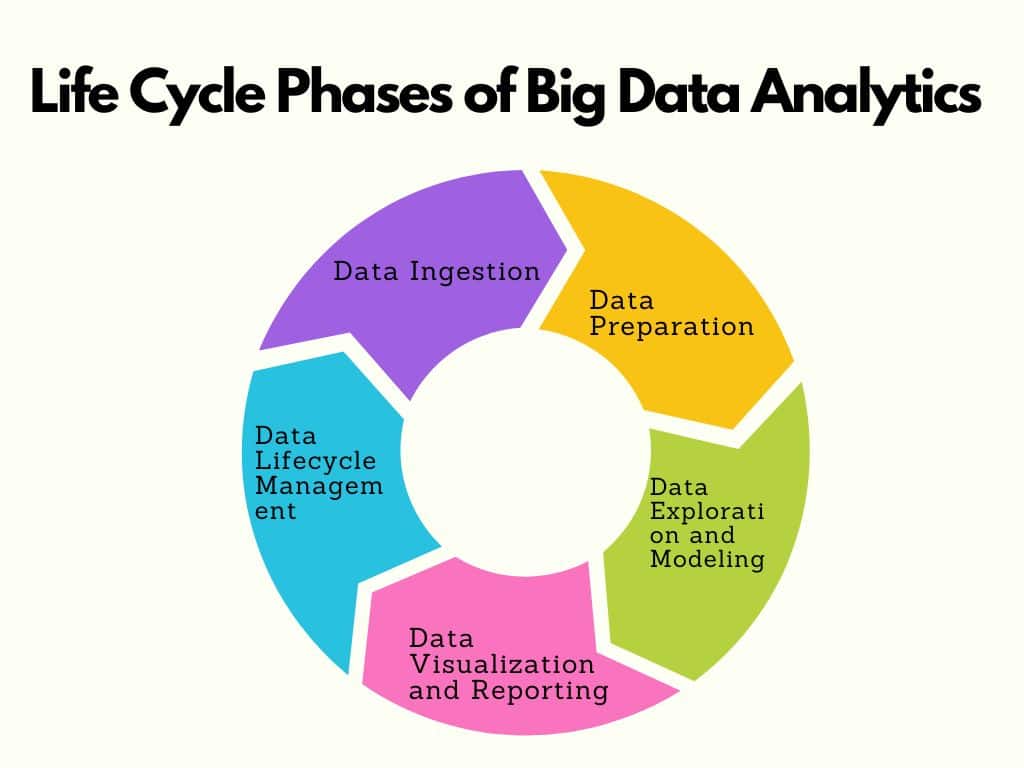
Tools and Technologies of Big Data Analytics, Few Examples of Big Data Analytics
Different big data analytics tools and technologies are used to process and analyze big data. Some of them are open-source, while others are commercial. Here are a few examples of big data analytics tools:
● Hadoop: It is an open-source, Java-based big data processing framework that helps you process and analyze large data sets.
● Apache Spark: It is an open-source, general-purpose big data processing engine that can be used for a variety of tasks, including streaming, SQL, machine learning, and graph processing. Spark is an open-source big data platform that’s used for processing and analytics.
● MongoDB: It is a popular NoSQL database used to store large amounts of unstructured data.
● Cassandra: It is another popular NoSQL database used to store large amounts of unstructured data.
● Tableau: It is a commercial data visualization tool that can be used to create interactive visualizations from big data sets.
● Pig: Pig is an open-source big data platform that helps you process and analyzes large data sets.
● Hive: Hive is an open-source big data platform that helps you process and analyzes large data sets.
Big Data Analytics Vendors
The following are a few of the Big Data Analytic Vendors in the market 4
- Zoho Analytics (free trial available)
- Alpine Data
- Alteryx
- Amazon Web Services
- Cloudera
- Datameer
- Domo
- Google Cloud Platform
- HPE
- IBM
- Microsoft
- MicroStrategy
- Oracle
- Pentaho
- SAP
- SAS
- SiSense
- Splunk
- Tableau
- Teradata
- TIBCO Jaspersoft
- VMware
Advantages and Disadvantages of Big Data Analytics
As with anything, Big Data Analytics has advantages and disadvantages. Let’s take a look at some of each.
Advantages:
● Analyzing Big Data helps uncover hidden patterns, correlations, and market trends.
● Using Big Data increases business agility and productivity.
● Big Data can help identify new business opportunities and areas for improvement.
Disadvantages:
● Challenges such as scale, data privacy, and data accuracy can be faced when using Big Data.
● Requires skilled personnel to manage and interpret the data.
● It Can be expensive to store and manage large amounts of data.
Applications of Big Data Analytics
There are a number of different applications for big data analytics. Retailers, for example, can use it to track customer behavior and preferences in order to stock their shelves better and design targeted marketing campaigns. Big data analytics can also be used in the healthcare industry to predict disease outbreaks, track the spread of infections, and develop personalized treatments. And in the financial sector, big data analytics is used for fraud detection, risk management, and portfolio optimization.
Big data analytics has a wide range of applications across many industries. Here are a few examples:
- Finance: Big data analytics is used in the financial industry to identify trends and patterns in financial data, such as stock prices and market movements. It is also used to detect fraudulent activity and to develop new financial products and services.
- Healthcare: Big data analytics is used in healthcare to improve patient care and outcomes. For example, it can be used to identify trends and patterns in patient data, such as medical history, demographics, and treatment outcomes. This can help healthcare providers to identify risk factors and tailor treatment plans to individual patients.
- Retail: Big data analytics is used in the retail industry to improve customer experience and increase sales. For example, it can be used to analyze customer data, such as purchase history and browsing behavior, to personalize recommendations and targeted marketing campaigns.
- Manufacturing: Big data analytics is used in manufacturing to improve efficiency and reduce costs. For example, it can be used to analyze data from sensors on factory equipment to identify maintenance issues before they become problems.
- Transportation: Big data analytics is used in the transportation industry to optimize routes, reduce fuel consumption, and improve safety. For example, it can be used to analyze data from sensors on vehicles to identify patterns and trends that can inform decision-making.
- Energy: Big data analytics is used in the energy industry to optimize the generation, transmission, and distribution of energy. For example, it can be used to analyze data from smart meters to identify patterns in energy usage and improve energy efficiency.
These are just a few examples of the many applications of big data analytics. It is a rapidly growing field with many potential uses.
So as you can see, big data analytics has a lot of different applications. And as the technology continues to evolve, we can expect even more innovative uses for it in the future.
Future of Big Data Analytics
The future of big data analytics is looking very bright. With the rapid expansion of data and the need for businesses to make better decisions, the demand for big data analytics is only going to continue to grow.
A few factors will drive the future of big data analytics. First, there will be an increasing need for real-time insights. This means that businesses will need to be able to analyze data as it’s being generated. Second, there will be a growing need for predictive analytics. This means that businesses will need to be able to use historical data to predict future trends. And finally, there will be a need for more advanced analytics, such as machine learning and artificial intelligence.
With the right tools and technology in place, big data analytics will continue to evolve and become even more powerful.
The future of big data analytics is looking very bright. As data sets continue to grow larger and more complex, the need for big data analytics will only become more apparent.
In the future, we can expect to see more businesses using big data analytics to make better decisions, improve their products and services, and save money. We can also expect to see more big data tools and technologies being developed to make the process of big data analytics easier and more efficient.
Big data analytics is an evolving field, and it’s constantly changing and evolving as new technologies are developed. One of the most exciting technologies on the horizon is artificial intelligence. AI can automate the data analysis process, making it even easier to uncover hidden patterns and insights.
Another promising area of development is edge computing. This involves bringing data processing and storage closer to the edge of the network, where data is collected. This can help to reduce latency and improve performance.
Finally, quantum computing is also starting to make its way into the world of big data analytics. Quantum computers can process huge amounts of data much faster than traditional computers, which could potentially revolutionize how businesses analyze data.
So if you’re looking for a challenging, interesting, and in-demand career, then a career in big data analytics might be the perfect fit for you.
Benefits, Challenges, and Skills Needed for a Career in Big Data Analytics
Big Data Analytics Challenges:
Implementing Big Analytics is not straight forward as most companies hope it will be. It comes with its own challenges, lets look at a few of them:
● Growth of Data: Exponential data growth rate is one of the biggest challenges; managing it will be very challenging with a huge volume of data. Hence, Big Data Analytic solutions must be able to perform well even at large scales if they are to be used for enterprise level
● Unstructured Data: Unstructured Data is again a big problem. Data like Images, Videos, audio files, emails, and other types of files come under Unstructured Data, which is very difficult to search unless and until advanced artificial techniques are available. Hence, examining and extracting useful insights from Unstructured Data is really challenging, which makes the vendors constantly update the big data analytics tools to be used to improve efficiency and accuracy
● Data Siloes: Integrating data from different departments(Enterprise Resource Planning (ERP) solutions, Customer Relationship Management (CRM) solutions, Supply Chain Management Software, Ecommerce Solutions, Office productivity programs, etc. ) is again a challenging task while dealing with the Enterprise applications, lack of coordination between various departments is highly possible.
● Data storage , processing, and maintaining the data quality and Data Security, using the right tools and technologies are a few other challenges in Big Data Analytics
Benefits of a Career in Big Data Analytics
There are many benefits to pursuing a career in big data analytics, including
• Earning a high salary, who doesn’t want a six-figure salary?
• Working with cutting-edge Technology
• Having a positive impact on society
Skills Needed for a Career in Big Data Analytics
There are several skills that are important for a career in big data analytics:
- Programming: Proficiency in at least one programming language, such as Python or Java, is essential for big data analytics.
- Data management: Knowledge of SQL and database management systems is important for working with large datasets.
- Data processing: Experience with tools such as Hadoop and Spark is important for processing and analyzing large datasets.
- Machine learning: Knowledge of machine learning algorithms and techniques is important for finding insights and patterns in data.
- Statistics: A strong understanding of statistical concepts and analysis is important for analyzing and interpreting data.
- Data visualization: The ability to create clear and effective visualizations of data is important for communicating findings to stakeholders.
- Problem-solving: Big data analytics involves tackling complex problems and finding creative solutions. Strong problem-solving skills are essential.
- Communication: The ability to clearly communicate technical concepts to both technical and non-technical audiences is important for explaining findings and collaborating with others.
- Time management: Big data analytics projects can be complex and time-consuming. Strong time management skills are important for meeting deadlines and managing multiple tasks.
What are the Three types of Big Data?
There are three types of big data: Structured, Unstructured, and Semi-Structured.
● Structured Data is the easiest to work with because it’s organized in neat columns and rows, making it easy to query.
● Unstructured Data is more difficult to work with because it’s not in a predefined format. It includes text, social media posts, images, videos, etc.
● Semi-structured Data is a mix of the two, containing some elements of structure and some that are unstructured.
Types of Big Data Analytics
There are several types of big data analytics, each of which suits a particular task. Some of the most common types include descriptive, predictive, prescriptive, and diagnostic analytics.
Each type has its own benefits and drawbacks, so it’s important to understand which one is right for your needs. For example, descriptive analytics is great for understanding what has happened in the past, while predictive analytics can be used to predict future trends.
Now that you understand the concept of big data and how it’s different from traditional data, it’s time to learn about the five types of big data analytics. They are:
● Descriptive Analytics: This is the most basic type of analytics and simply describes what has happened in the past. For example, looking at historical sales data to see what products were popular.
● Diagnostic Analytics: This type of analytics drills into the data to find out why something happened. For example, looking at sales data to see why a particular product was popular.
● Predictive Analytics: This type of analytics uses historical data to predict future trends. For example, using sales data to predict what products will be popular in the future.
● Prescriptive Analytics: This type of analytics predicts future trends and provides recommendations on what to do about them. For example, using sales data to predict what products will be popular in the future and recommend actions to take to capitalize on that trend.
● Cognitive Analytics: This is the most advanced type of analytics and uses artificial intelligence (AI) to make sense of big data. For example, using AI to analyze sales data and identify trends that would be difficult for humans to spot.
Applications of Big Data:
The following are a few of the applications of Big Data in various Industries: 9
- Banking: Banks can use Big Data Analytics to identify income and spending patterns and can determine whether to offer a loan, credit card, etc
- Telecommunication: Big Data Analytics can be of great use in the Telecom industry. That helps in analyzing the network speed, and the traffic across a particular channel hence helping in providing the best customer experience possible
- Social Media: Big Data Analytics plays a major role in Entertainment as it can help to identify targeting the right content to the users, which in turn can help businesses to target the right audience. It is also a great option for movie and series recommendations.
- Ecommerce: Predicting trends and providing offers based on the market requirements that can increase sales can be of great help by Big Data Analytics here.
- Healthcare: Big Data Analytics can play a major role in Healthcare Industry, in which the patient health in the future can be determined and can be warned of any health issues that are likely to occur in future by analyzing the patient’s medical history
How to Improve the Accuracy of Big Data Analysis
The accuracy of big data analytics can be improved by using the right tools and techniques.
Here are a few strategies for improving the accuracy of big data analysis:
- Clean and preprocess the data: Ensuring that the data is clean and correctly formatted is essential for accurate analysis. This may involve removing missing or erroneous data, normalizing data, and handling outliers.
- Use appropriate algorithms: Selecting the right algorithms and modeling techniques for the task at hand is important for improving accuracy. Consider factors such as the size and structure of the data and the nature of the problem you are trying to solve.
- Use cross-validation: Cross-validation is a technique for evaluating the accuracy of a model by dividing the data into training and test sets and using the training set to build the model and the test set to evaluate it. This can help to prevent overfitting and improve the accuracy of the model.
- Use ensembles: Ensemble methods involve combining the predictions of multiple models to improve accuracy. By aggregating the predictions of several models, you can often achieve better results than by using a single model.
- Monitor and evaluate results: It is important to monitor and evaluate the results of big data analysis to identify any issues or areas for improvement. This may involve using metrics such as accuracy, precision, and recall to evaluate the performance of the model.
By following these strategies, you can improve the accuracy of your big data analysis and increase the usefulness and value of your insights.
Use of Big Data with a Use Case:
The word Big Data refers to structured, semi-structured, and unstructured data, which is huge in Volume, Velocity, and Variety.
Let us look into this in detail with an example:
Let’s say, for example, user A is browning a website X for a shirt. Unfortunately, the shirt the user A is searching for is out of stock. However, website X shows similar shirts based on his search; hence user A ends up buying two to three shirts now instead of one. The website X will again send a mail to user A once the shirt he was initially looking for is back in stock. Here the goal of more sales and happy customers is fulfilled, but how exactly did this happen?
Over time, website X collects lots of data (Volume) about many customers like Users A.Similarly, the data is collected in the food, games, social media engagement, etc ( Variety). Hence website X collects data at different rates ( Velocity ). Some over a period a time and few Being live data. The algorithms that can analyze the customer’s behavior are used in this aspect hence making the best use of the data. With this, the following can be achieved:
- The customer’s needs will be fulfilled without extensive search (in our case, shirt)
- Greater Revenue by showing and recommending what customer wants
- Continuous learning by the system, through which the system suggestions can be completely accurate in the future that might match the customer’s likes and wants
Hence in this way, Big Data Analytics can be used to :
- Get actionable insights.
- Uncover hidden patterns.
- Find correlations in data.
This helps businesses to cut costs, increase their revenue with minimal manual intervention, improve business productivity and create much more intelligent organizations.
Conclusion
The fact is, big data analytics is not just a passing fad. It’s a game changer that is only going to become more important in the years to come. Businesses that don’t unlock the potential of big data analytics are going to be left behind.
So what are you waiting for? Start exploring the possibilities of big data analytics today and see how you can improve your business performance. By now, you should know what big data analysts do, the skills they need, and the career opportunities available to them. The world of big data is growing rapidly, and analysts who are able to harness the power of big data analytics will be in high demand. So what are you waiting for? Start learning today and see if a career in big data analytics is right for you!
Big Data Analytics FAQs
Big Data Analytics is the process of examining huge volumes of data to uncover hidden patterns, correlations, and useful insights. . It’s vital for businesses that want to make data-driven decisions, and it can be used for a variety of purposes, such as marketing, product development, and research.
A Big Data Analyst is responsible for taking all of the data your company collects and turning it into valuable insights. This data can come from a variety of sources, including social media, website traffic, customer transactions, and even GPS data from cell phones.
The insights a big data analyst can provide can help your business make better decisions about how to grow and improve its operations. For example, if you’re a retailer, you might use big data analytics to figure out which products are most popular in which regions or to identify buying patterns that could suggest new marketing campaigns. The following are a few uses :
● Increased Innovation
● Cost Reduction and Time Reduction
● Improved customer acquisition and Retention
● Faster Analytics and Decision Making



